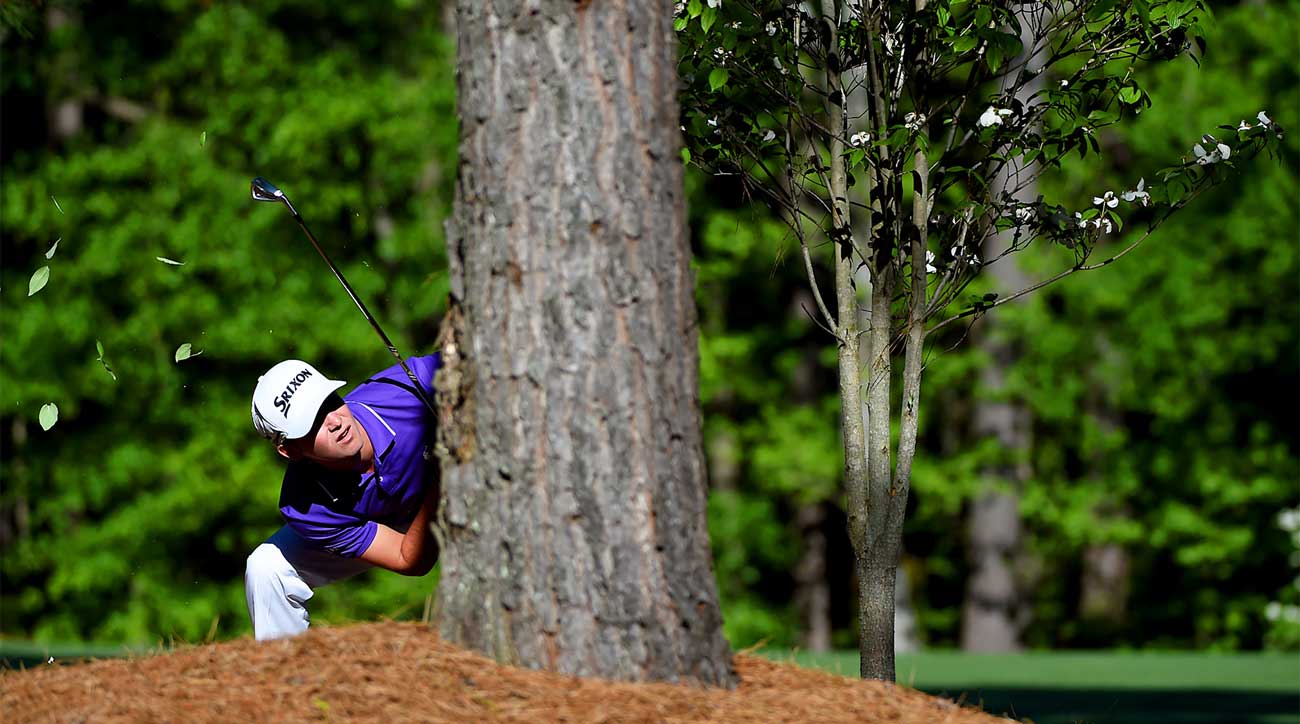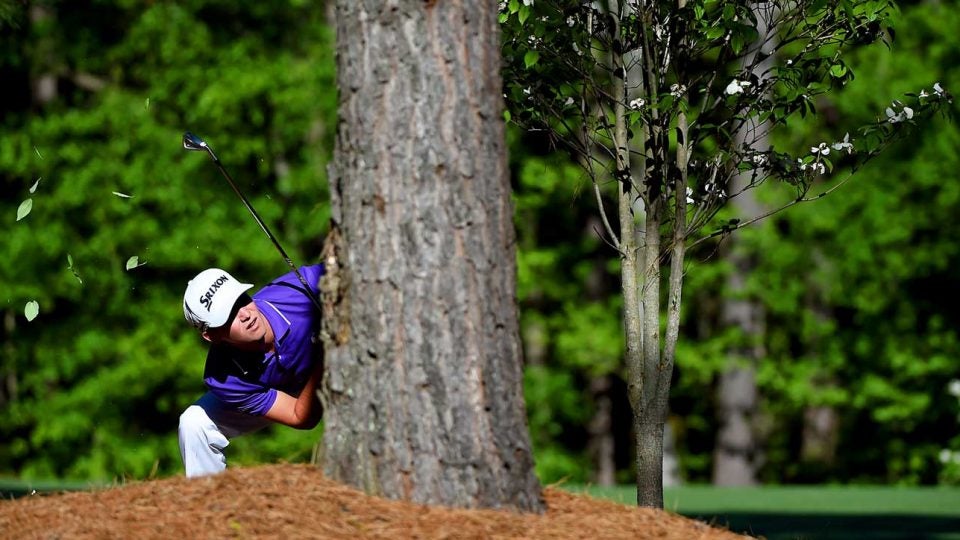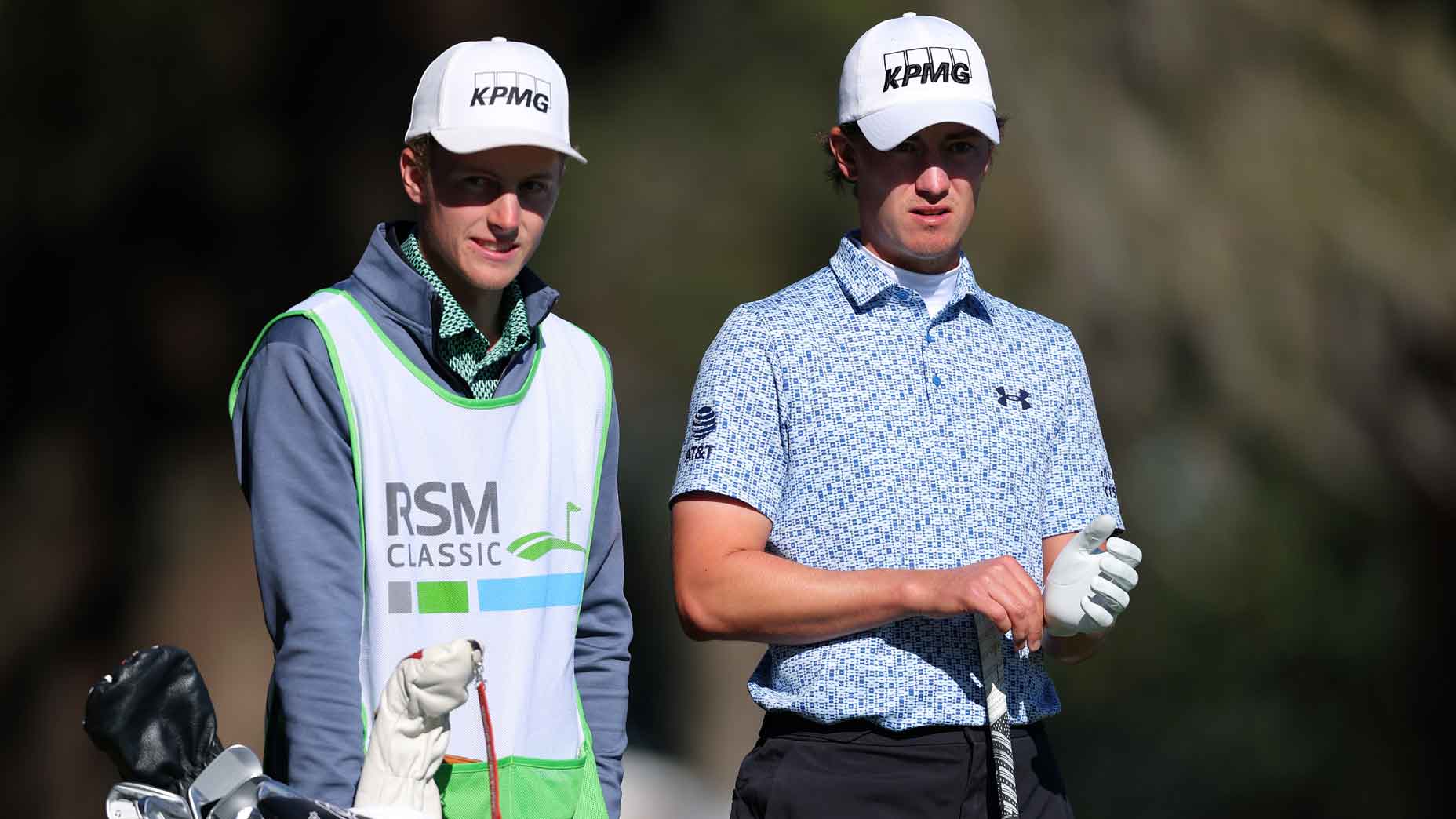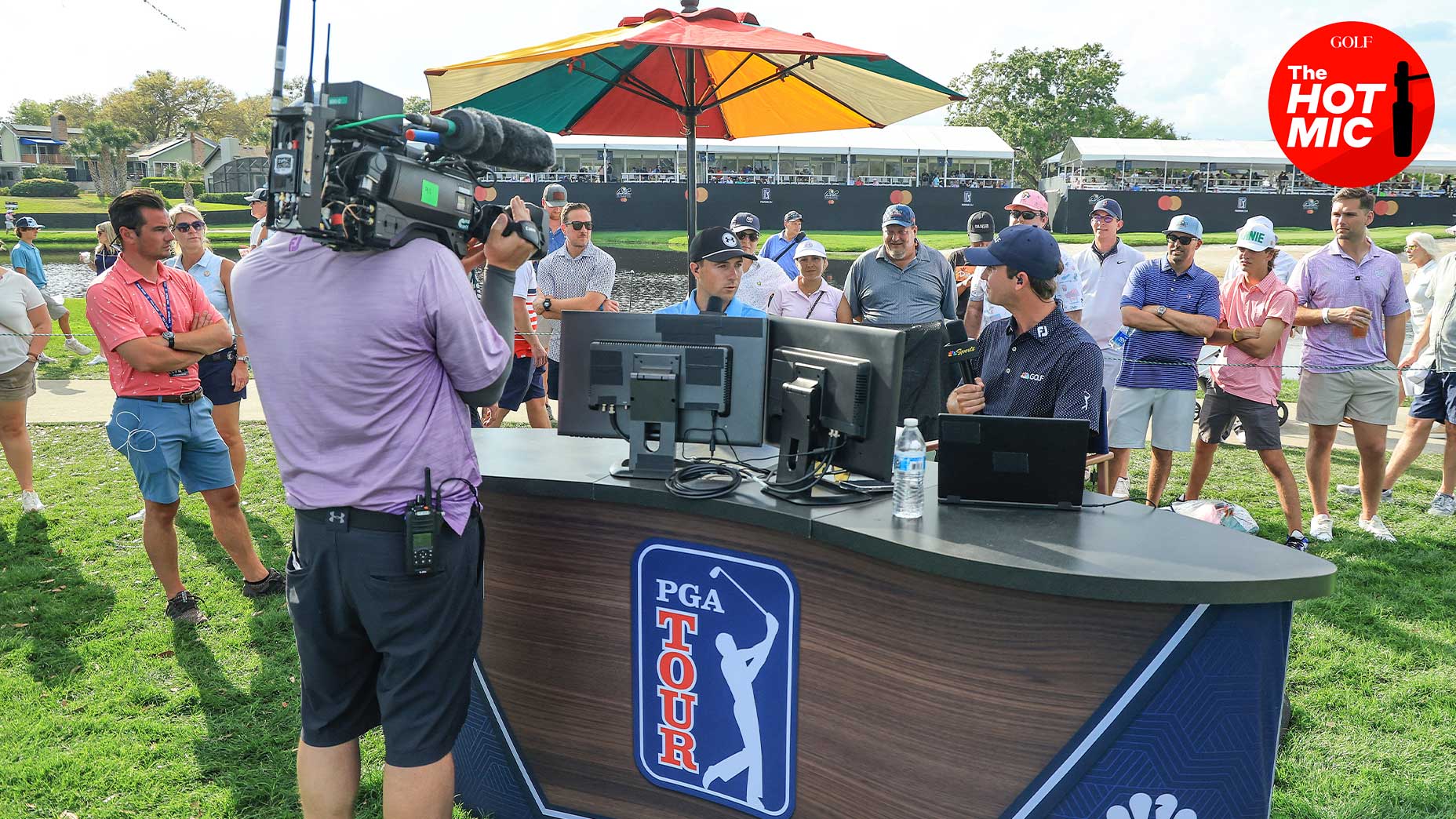This is the seventh and final installment of our Modern Pro series, in which GOLF.com is breaking down what it means to be an elite professional golfer in 2018. In previous editions, we broke down players’ swings, bodies, brands, lifestyles, money and geography. This week we delve into their minds.
***
Augusta National Golf Club, Sunday, April 10, 2016. Jordan Spieth is seated alone at a round table in the men’s locker room, eating a salad and occasionally peeking up from his phone to catch highlights of the 1993 Masters. On the TV screen, a mulleted, 35-year-old Bernhard Langer stripes an approach into 13. “The ball doesn’t hang back there anymore,” Spieth says, referring to how Langer’s shot bounded into the green and didn’t run off the back​. Spieth may as well be talking to himself, because no one around him — a few cooks, servers and writers — dares engage the young Texan on the brink of what will be one of the most important rounds he will ever play. Not that you can detect the enormity of the moment by studying Spieth. Despite sitting on the lead on Masters Sunday, the 22-year-old is the picture of cool.
Smylie Kaufman, 23, isn’t quite so comfortable. This is his first time competing in the Masters, and, he, too, has a big day ahead of him: After three stellar rounds he trails Spieth by just one shot and will play alongside his buddy in the final pairing.
“I was playing really good golf,” Kaufman recalls today. “But I didn’t know what I was getting into or what to expect.”
He’s right, on both accounts. Two top-15 finishes during the prior month was good golf. So was the 69 Kaufman shot during a windy third round. But he wasn’t prepared for the weight of Masters Sunday. Kaufman became unusually chatty, yapping away to his then-caddie, Aaron Alpern — “just to deal with the nerves.” Could you blame him? There is no grander stage nor more perfectly groomed venue to lose your damn mind than at Augusta National.
“Most guys thrive on feeling that,” says Dr. Bob Rotella, one of the foremost practitioners of golf and sports psychology. “You’re gonna feel some butterflies, and they love that…Pressure is what these guys crave.” But pressure can also shred you. Despite out ball-striking Spieth, as he believed he did on the front nine, Kaufman had what he characterizes as his “D- or F-stuff” on the greens. He three-putted five times and shot 81, his worst score as a professional.
Kaufman left Augusta with unanswered questions. How high could his peak be? Why did his putter desert him? What about the big stage made him want to talk, talk, talk? Why, as he recalls, did the greens seem to turn purple overnight? Maybe most importantly, what did he need to do to build a winning mindset in big moments?
For more than a decade, Tiger Woods thrived under pressure, winning ruthlessly as competitors crumbled around him. Current world No. 1 Dustin Johnson has the same Actions Speak Louder (and Better) Than Words mentality. But what about those players not blessed with boundless talent? Kaufman’s 81 was a reminder that at the highest level of golf, everything is amplified — especially mistakes. And those mistakes can have ripple effects in the weeks, months and years that follow.
If Kaufman’s 81 had been a 75, he would have finished tied for 10th and earned an automatic invite to the following year’s tournament. He would have been playing golf at Augusta in 2017 instead of fulfilling a sponsorship appearance drinking Natty Light at a local Midas shop.
Since that fateful Sunday, Kaufman has endured 22 months of mostly frustrating golf. Initially it was inflammation in his right wrist. Then rehab for that injury. Then he developed some bad habits as other minor injuries came and went. Some of the habits have been physical, others have been mental.
“I was trying to play too much perfect golf and not hitting the right shot that the hole required,” he said. “I was hitting a lot more wild shots by trying to hit the perfect shots.”
All Tour pros chase perfection. For a while there, it appeared Kaufman had found it. In just the second event of his rookie season, he made a 19-foot birdie putt on the 72nd hole of the 2015 Shriners Hospital Open to card a 61 (29 on the back nine) to edge the six stunned players who tied for second. That title earned him a spot in the 2016 Masters and vaulted 150 spots in the world golf ranking. Having so much success so early in one’s career can warp a player’s expectations. Kaufman has learned that over time. So has Chez Reavie.
Reavie, now 36, also won a Tour event during his rookie season, the 2008 Canadian Open. It vaulted him nearly 200 spots in the world ranking and sent him to the Masters for the first time as a pro. Sound familiar? “Once you win and you get a little success, then you struggle a little bit, you start pressing,” Reavie says now. “You’re trying to hit every shot perfect.”
Reavie made a bunch of cuts that year and was in the running for Rookie of the Year alongside thoroughbreds Dustin Johnson and Jason Day. But eventually, his game soured. Lulls happen; the key is limiting those downturns to three or four weeks and not three or four months. Reavie wasn’t able to. He missed the cut in more than half his events in 2009, securing just one top 10 along the way.
“I didn’t realize how much I was judging myself out there on every shot,” he says. “The things I was saying to myself and the talking I was doing in my own head, I would have never said to another person.
“Part of it is being a perfectionist and wanting to do it all so perfectly — wanting to succeed and wanting to win. You see people around you doing it and you feel like you can do it, but yet I wasn’t.”
In 2010, Reavie made just six cuts in 15 events before suffering a serious knee injury in May. His season was over, forcing him to play 2011 on a major medical exemption. After another underwhelming season, Reavie made a run in the year-end playoffs and though he failed to win an event, he kept his Tour status for 2012.
Spurts of his excellent golf were bailing Reavie out, but he still hadn’t learned to be easier on himself when success didn’t happen. Later in 2012 came a revelation.
Reavie was headed to the Final Stage of PGA Tour Q-School when he met Bryan Hepler, the founder of Tathata Golf, a training program centered around “complete understanding and all-knowing.” Hepler found that, while Reavie’s game was solid, his mind needed a new method for processing mini mistakes.
“I needed to realize that just because I hit this shot poorly or that it didn’t go perfect, it has zero bearing on the next shot that I hit,” Reavie says. “The next shot that I hit could be the best shot that I ever hit…It didn’t matter. I started thinking about that and was like, ‘Wow. I’ve never really looked at it that way.’ I was always like, ‘Oh, s—, I pulled my last 7-iron so let’s try and hold this one off a bit. Well, then I’d probably hit the next one to the right. I was just chasing my tail, whereas this way, every shot was a fresh start.”
Call this Phase 1 in the Reclamation of Chez Reavie. At 2013 Q-School, he tied for 22nd to earn Tour status. When a wrist injury in 2014 prompted another surgery, the old Reavie might have lost his direction entirely. Instead, the new Reavie focused on each additional opportunity as a blessing. “I knew some people that had the same wrist surgery I had who didn’t make it back,” he says. “That was a really stressful time for me because I didn’t know I was going to be able to play anymore. When I get out there, if I have a couple poor weeks and am kind of down, I’ll look back on that and say, ‘Hey man, it’s been a lot worse. It can be a lot worse. Just keep your head down and keep moving forward.'”
Reavie took off during the 2015 Web.com Tour Finals, finishing T10, 1, T20 and 2 to lead the Finals money list. Back to the PGA Tour he went. In 2016 he made 67% of his cuts. A year later, 75%. So far this year he’s a perfect 10-for-10 at leaving events with more money than he showed up with. It hasn’t been a linear path — it rarely ever is — but Reavie is playing the best golf of his life. He’s ranked 43rd in the world (a career high) and has finished in the top 25 in 10 of his last 13 Tour starts. He’s become a bastion of consistency on the fairways and he teems with positivity.
“It’s not just golf,” Reavie says. “You’re standing in line and someone cuts you. How do you handle it? Do you say something to them or do you let it go and realize they might be having a bad day…It’s all about creating positive energy. Having good energy every day, and how to create it if you don’t have it.”

To create that good mojo whenever and wherever he goes, Reavie employs a team. There’s his swing coach, two trainers (one where he lives in Arizona and one on the road) and a sports psychologist. Reavie receives motivational texts from his squad, he has vision boards and a surplus of ears for venting sessions. His wife Amanda is his biggest supporter. They’ll get in a car together after a round and he’ll spill his emotions for 30 minutes. “Thirty minutes to kind of be pissed off about this, and after that I’m not allowed to be pissed anymore,” he says.
Reavie doesn’t see value in calling up his coach 15 minutes after signing for a 76 to moan about the breaks that didn’t go his way. In fact, Reavie’s swing coach protects against that with all his students. Mark Blackburn, who began working with Reavie in 2015 and who also coaches Kevin Chappell and Heath Slocum, operates with a “three-hour rule.” He won’t allow any of his players to call him until at least three hours after their round.
“Unfortunately it takes a lot of mental strength and aptitude,” Blackburn says. “After rounds, most of the time players are highly subjective and irrational. You have to allow them plenty of time for reflection.”
Blackburn came up with that three-hour cool-off period solely through his own experiences. “Well, how long do I get pissed off about something?” he says. “After three hours, unless it’s life-changingly bad, you tend to be much more rational.” As a coach, he relishes those subtle ways in which he can steer players toward improvement without seeming too forceful. He gives every player he works with a tiny Batman Lego keychain as a memento because he wants them to feel like Batman.
“Batman is a flawed, normal individual,” Blackburn says. “But when he puts the cape on, he’s like a f—ing superhero…It’s a reminder that they are normal people, but when they stand on the 1st tee, they’re Batman.”
Blackburn is not a sports psychologist. He’s a swing coach, but he’s playing the role sports psychologists refer to as a holistic coach: a guide who can help his players keep their swings on plane, stay motivated in the weight room, make smart decisions on the course — a sage for all things, golf and beyond.
“There are coaches who are brilliant at removing doubt and making people believe,” says Dr. Bhrett McCabe, sports and performance psychologist (and source of the Batman analogy). “There are people who are great at helping others find their pathway. There are others who are great at being a buddy. That’s what makes coaching so important — whether it’s mental or physical coaching — it’s being adaptable and intuitive to what the player needs…I can guaran-damn-tee you that [Jordan Spieth’s coach] Cameron McCormick is a brilliant mental coach without being a licensed mental coach.”
A look across the Tour reveals a variety of those approaches. Whether the inspiration comes from coaching, reading, exercise, a caddie, wife or friend, players need something to believe in.
Kevin Streelman believes he can shoot 54. That’s 18 birdies on 18 holes, a perfect round under the ethos of Vision54. It’s a program focused on understanding how six aspects of your game (physical, technical, mental, emotional, social and spirit of the game) work together. In theory, when those aspects are in sync, a golfer is finally free to achieve his or her own absolute peak. For a Tour pro, that’s 18 under par.
Anirban Lahiri chased clarity of mind in a slightly different way, about as far down one end of the spectrum as possible. Lahiri ventured to the Massachusetts backwoods last summer and enrolled in a 10-day meditation clinic during which he didn’t speak. The idea is simple: controlled breathing leads to a settled body, uninhibited as possible from distraction and unnecessary sensations.
Jason Day found something like that, too. As Alan Shipnuck reported in 2014, Day and performance coach Jason Goldsmith created a 15-step pre-shot routine where Day focuses “on his breathing, posture, and what Goldsmith calls ‘mind-body awareness,'” to settle himself into mushin, a Japanese word that means “mind of no-mindedness,” which is most popular in martial arts.
One popular belief system can be found in every hotel room in America. As Zach Johnson watched Louis Oosthuizen miss a putt at the 2015 British Open that secured Johnson the claret jug, Johnson was reciting Bible scripture in his head. He had been doing it all week. His scripture of choice was Psalm 27:14, which reads, “Wait patiently for the Lord. Be brave and courageous. Yes, wait patiently for the Lord.” That week in St. Andrews, Psalm 27:14 served as Johnson’s five-second reminder to stick to his priorities.
The examples go on, which isn’t to say the mind-over-matter mentality is for everyone. When contacted for this story, one major winner’s agent said, “Yeah, you’ll want to talk to him because he’ll tell you exactly what sports psychologists are. They’re bull—.”
Skeptics aside, there’s no question an increasing number of Tour players spend more time on their mind games — and convincing themselves that they’re good enough to be out there — than players from previous generations.
That’s exactly how Smylie Kaufman has moved forward from his Masters meltdown. Today he thinks of that dreadful Sunday as a lesson, a tool in his work belt that many other pros don’t have. His swing coach and confidant, Tony Ruggiero, thinks the same way.
Ruggiero, 46, is a holistic coach. Of the 10 or so people in Kaufman’s inner-circle, Ruggiero gets the most ear-time, by far. They’ve worked together since Kaufman was an undergrad at LSU, and now they talk on the phone nearly every day. At the 2016 Masters, it was easy to spot Kaufman’s cadre — they were all wearing white Srixon hats. It was perhaps even easier to spot Ruggiero, the coach grinning ear-to-ear and laughing as Kaufman stuck his approach on the 14th green on Friday for another birdie. Now it’s up to the duo to return Kaufman to those heights.
“Obviously he didn’t play the way he wanted to finish that thing off,” Ruggiero says. “But the experience he got, when he gets in that position again…it’s going to benefit him.”
That’s the belief, at least — a belief that serves not just as hope but as motivation, too. Toward the end of 2017, the pair grinded through practice sessions together with the goal of returning Kaufman to his old form. But Ruggiero and Kaufman haven’t really discussed the Masters, keeping it purposefully distant in the rearview mirror, if not totally out of sight.
“I haven’t referenced it once since that Sunday what happened at Augusta. We haven’t had an opportunity that I’ve felt it would benefit to bring it up,” Ruggiero said. “But we’ve got it in our bag. At some point there’s going to be a chance to do that.”








